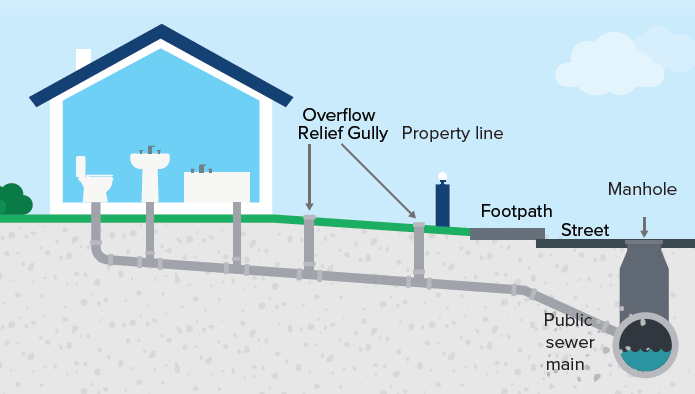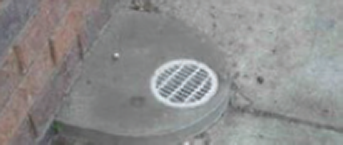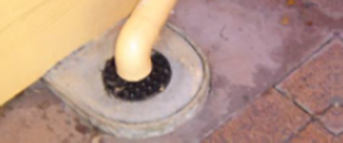Wastewater (sewage)
If you notice damaged or overflowing sewerage mains or access-holes, please call us on 07 3412 3412 as soon as possible.
If you have a problem with the sewerage pipes on your property, please call a licensed plumber in the first instance.
We repair blocked and damaged sewerage mains outside of your property boundary.
Sewage Overflow
Heavy rain can cause stormwater to flow into the sewerage network. This can overload the network and make it overflow. Stormwater enters the sewerage network through:
- illegal roof and property connections
- damaged property drains
- unsealed access-hole lids
- leaks in the network due to damage.
We have designed our sewerage system to overflow at set points. This stops sewage from overflowing in private properties. To learn more, download our Sewage overflow factsheet (PDF 549 KB).
Overflow relief gully
An ORG is a plumbing fitting located outside your home designed to release wastewater if there is a pipe blockage or network overload.
How does it work?
If a sewerage blockage occurs, the ORG grate should pop off to release the pressure from the pipes and direct wastewater away from the home.
Plumbing regulations apply to the installation of ORGs (AS/NZ 3500.2:2021). An ORG should be installed:
- at least 150 mm below the lowest internal drain fixture (e.g. bathrooms, toilets and the laundry), and
- 75 mm above the surrounding finished ground level (except where the gully riser is in a path or a paved area, in this case it must be finished at a level that prevents rainwater inflow into the wastewater system during rain events).
The image below shows the ORG network

Whose responsibility is the ORG?
It is the property owner’s responsibility to make sure the ORG is properly fitted and maintained. If you are unsure of the condition of your ORG, please contact a registered plumber. If you have more than one bathroom in your house, you may have more than one ORG.
Do you have an illegal or incorrect stormwater connection?
A common point where stormwater can enter the sewerage system is the ORG. Stormwater run-off from water tanks or downpipes should not be directed to your ORG. Preventing stormwater from entering the sewerage network helps reduce sewer overflows.
Caring for your ORG
| Do | Don't |
|---|---|
|
|
A correctly installed ORG

Incorrectly installed ORG

Downpipes should not be directed into an ORG.
What to do if you have a sewage overflow
- Never touch raw sewage with your bare hands. Wear rubber gloves when handling anything contaminated with sewage and wash your hands immediately afterwards.
- Keep children and pets away from the sewage.
- Contact Logan Water on 07 3412 3412 to advise of the overflow.
- Contact your home insurance company, and if applicable, your property manager or landlord to advise of the overflow.
- Always wear protective gear if in contact with the sewage like goggles, gloves and gumboots.
- Protect all wounds and cuts and immediately wash and disinfect any wounds or cuts that come into contact with sewage.
- Do not flush your toilet until the cause of the overflow has been fixed.
- If you have any health concerns, please seek medical advice or call 13 HEALTH.
What to do once the sewage is cleaned up
- Clean, disinfect and dry all hard surfaces thoroughly.
- Disinfect all equipment that may have come into contact with sewage - bleach solutions are the most effective disinfectants.
- Absorbent items that have been contaminated should be thrown away. For example, carpets, rugs, cardboard, stuffed toys, mattresses and pillows.
- Make a list of items to be thrown away and take photos for insurance purposes.
- Wash all clothing worn during the cleanup in a separate wash.
- A professional cleaning company may be required to undertake further cleaning depending on the extent of the overflow.
Reducing sewage overflow
We work to reduce overflows by:
- regularly inspecting and repairing damaged pipes and access holes
- providing controlled overflow points
- monitoring the performance of the network
- reducing how much stormwater can get into the sewerage network.
You can reduce the amount of stormwater going into the sewerage network by:
- making sure your roof water or garden drainage do not connect to overflow relief gullies
- replacing faulty and damaged household drainage pipes.
For more information, please download the Overflow Relief gully factsheet (PDF 204 KB).